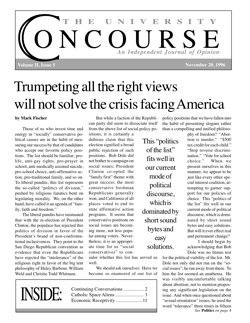Did they dance at the crucifixion?
by Andrew L. Bloomfield
The previous articles regarding “liturgical dance” and its appropriate place and form have been well-written and clearly presented. However, several points of clarification need to be made before a continued discussion of this current topic will bear fruit.
There is, first and foremost, a vital distinction between “liturgical dance,” properly so called, and those other forms of dance which are extrinsic to and outside of the Mass itself, i.e., prior to the Introductory Rites (specifically, the greeting and sign of the cross), and following the Concluding Rite (specifically the Ite, missa est). The term “liturgical dance,” therefore, refers only to dance within the Mass. In the western Church, the practice of liturgical dance, according to the Sacred Congregation for the Sacraments and Divine Worship, as such, is illicit.1
Not wishing to contest the Ordinary Magisterium and argue for liturgical dance, I move to address the second form of religious dance, namely that which is “performed” in a liturgical context, but not within the body of the Mass. This seems to be the sort of dance Kay Cummins defends in her Issue 4 article, “Dancing for God.”2
I also do not wish to contest that form of religious dancing which is clearly in conformity with the Congregation’s decree on dance, so long as it does not take place in the context of the Holy Mass, or in a place properly liturgical. Such was the dance that occurred in St. Peter’s square in Rome, following a missionary Mass celebrated by Samoan priests in 1971.
The appropriateness of dance within a liturgical context hinges on the essence of the Mass itself. Mrs. Cummins states: “The liturgy is primarily a communal act that reaches a climax in the sacrament of the Eucharist or Holy Communion.” On the contrary, the holy sacrifice of the Mass “is at the same time, and inseparably, the sacrificial memorial in which the sacrifice of the cross is perpetuated and the sacred banquet of communion with the Lord’s body and blood” (Catechism of the Catholic Church, 1382). References stressing the primarily sacrificial nature of the Mass are also abundant in Canon Law, and both the Second Vatican and Tridentine Council documents. We see, then, that Holy Mass is not primarily communal, but indeed is the summation and unity of communion and sacrifice. There can be no separation of or distinction between the two; the Mass is the re-presentation of Christ’s sacrifice on Calvary in an unbloody manner with the body of the Christian faithful. They are one and the same sacrifice, continued now sacramentally.
The critical question in our discussion follows: can dance, in the western Church, offer the body of the faithful any addition or supplement, either sacramentally or actually, to the unity and essence of the sacrifice of Christ on the cross in union with the sacrifice of the priest as alter Christus in the Mass? Clearly, the answer can only be in the negative.
The thought barely formed, the objection immediately arises, “Do, therefore, singing, or other bodily postures during the course of Mass, indeed anything which is not essential to the Mass, then offer no addition or benefit to the faithful who assist at Mass?” Although similar at first glance (both dance and music do, after all, manifest aesthetically the mind and heart of man), upon a closer look, we see the intrinsic difference between dance and sacred music,especially, in the cultural context of western society and spirituality. The Second Vatican Council recognizes the treasure that the Church has in her sacred music; Gregorian Chant is to hold “pride of place” in the Sacred Liturgy because of both its intrinsic sublimity and its unity with prayer. Dance has no such tradition or intrinsic connection to the essence of the Mass.3
I do not wish to contest the aesthetic value of dance, or even its capacity to assist certain people in worship; the fact remains, however, that dancing in the West carries with it feelings and inclinations which are contrary to purity and devotion; it is the introduction of the secular into the realm of the sacred.4 For a fallen man, suffering from the effects of the wound of concupiscence, to experience the aesthetic pleasure of graceful and beautiful women, even in prayerful and solemn adoration, in a religious dance before the Mass, is at the very least an opportunity for the occasion of sin. This fluidity of motion and beauty can have the unwanted effect of drawing the mind and heart to the world, instead of inspiring a prayerful and meditative spirit and lifting the mind and heart to God as preparation for the sacred mysteries.
Understanding, then, the great beauty and discipline with which dance is performed, and understanding the sincerity of heart of those who are inspired and uplifted by this mode of worship, it is nonetheless apparent that in the West, religious dancing as a liturgical practice poses both a pastoral and theological difficulty. Pastorally, it can be a hindrance to purity and chastity; theologically it does not and cannot add to the unity of the Mass in its principal essence as the sacrifice of Christ.
Did they dance at the crucifixion?
Andrew Bloomfield, Senior, philosophy and mathematics
- Both Fr. Stravinskas’ Catholic Encyclopedia and Fr. Hardon’s Catholic Dictionary define liturgical dance as I describe above. The prohibition against such form of “worship” in the Latin Rite is not found directly in Canon Law, but rather in an article of the Notitiae published by the Sacred Congregation of the Sacraments and Divine Worship in 1975, Volume 11, p. 202-205. To quote: “if the proposal for a religious dance in the West is to be acceptable, care must be taken that this occurs outside of the liturgy, in assembly areas that are not strictly liturgical. Moreover, priests must always be excluded from the dance.” ↑
- I assume that dance prior to the Mass is not intended to be part of the Mass, but only as a method of preparation; therefore the Congregation’s article would seem to permit this. ↑
- The council notes that the Church’s liturgical and sacred music is a “treasure of inestimable value, greater even than that of any other art…As a combination of sacred music and words, it forms a necessary or integral part of the solemn liturgy” (Sacrosanctum Concilium, 112). The council stresses this importance throughout Chapter VI of the Constitution. No such tradition of sacred dance exists in the West. ↑
- Again, the article from the Congregation is instructive: “Here [in western culture] dancing is tied in with love, with diversion, with profaneness, with unbridling of the senses; such dancing in general, is not pure.” For a society which has become increasingly sensate and desensitized to the true beauty and worth of the human body and its discipline, dance is a challenge to the soul, and no longer a help. ↑


